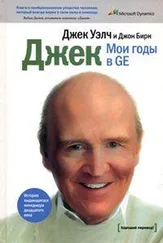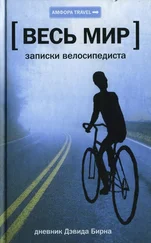When I head downtown on the new Ninth Avenue bike lanes, as I do fairly often, I notice the difference. I instantly feel as if a weight has been lifted. I no longer feel that I have to be quite as paranoid. I’m not afraid that a driver might swerve into “my” lane, and to some extent the usual adrenalized state I get into when negotiating the New York City streets almost dissipates, for a few blocks anyway. I move faster too—there’s no jockeying around double-parked cars, pedestrians, delivery vans, and cabs picking up or discharging fares.
After the Town Hall event the Department of Transportation approached me about judging a contest to design new bike parking for New York City. I agreed, and suggested that though we need more individual racks here and there, it is in places where people congregate—or will congregate in the future—that the issue most urgently needs to be addressed. Movie multiplexes, music clubs, schools, greenmarkets, and parks where New Yorkers sunbathe and cruise each other need lots of bike parking, not just a couple of racks. In Williamsburg a parking spot alongside the Bedford Avenue L-train station—the main subway station funneling hipsters to and from Manhattan—was taken over by the DOT and built out to make a bike parking area the size of a car space. Quite a number of bikes can fit in here, and it’s chockablock most of the time. Trading a parking spot here and there for bike parking real estate seems practical—there’s nowhere else to put a sizable rack, unless a nearby building has a plaza.
In Tokyo I rode to a complex that includes movie theaters, restaurants, a museum, and high-end shops. It had a room devoted to bike parking with contraptions enabling double-decker stacking. And it was free. To some extent that room was built to prevent people like me locking up to railings and posts—places that might cause pedestrian bottlenecks. So it’s not just 100 percent altruistic—it’s practical too.
When I agreed to co-judge the rack designs I sketched out some amusing smaller bike rack ideas of my own, each for a specific New York City neighborhood, and passed them on to the DOT. They were not meant as serious proposals, but as an incentive to loosen up. To my surprise the DOT responded, “Let’s do these! If someone pays for fabrication we’ll put them up.” There is a dollar-sign-shaped rack for Wall Street, a high-heeled-shoe-shaped rack for upper Fifth Avenue, a doggie-shaped rack for the Village, an abstract shape for MoMA, etc. Because these are for specific neighborhoods they’re not made to be mass-produced—hence the DOT asking for someone else to cover fabrication costs.
Here is my drawing of one called The Olde Times Square :
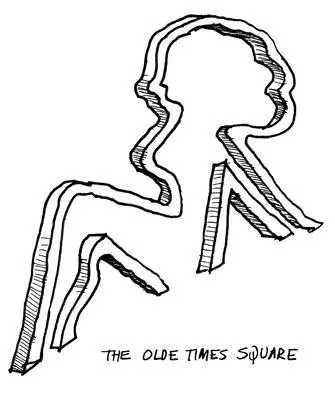
Here is the one in front of the luxury department store Bergdorf Goodman:
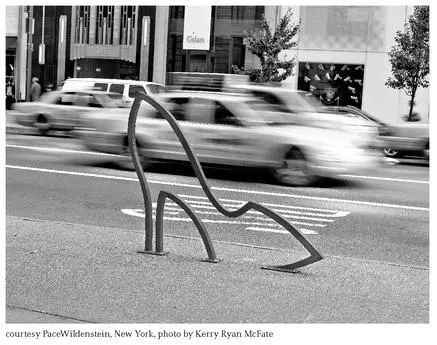
Because these racks are one of a kind they really aren’t offered as a solution to the bike-parking problem. But they did draw some attention to the issue. Some months later the real winner was chosen—an elegant and practical wheel-shaped design (see following page).
Last year Transportation Alternatives invited me to a meeting organized by the Manhattan borough president about transportation issues in New York City, which was held at Columbia University. I was not able to stay for the whole thing, but was excited to meet Enrique Peñalosa, and to hear him speak.
Peñalosa’s innovations had the effect of relieving congestion, boosting the economy, and making Bogotá and the surrounding suburbs a better place to live. Some credit should also go to Jaime Lerner, the former mayor of Curitiba, a Brazilian city that made some of these changes previously and that serves as an inspirational and ongoing example for clever and inexpensive urban planning. In the ’70s Lerner proposed a bus-based rapid-transit system for that booming city, which is now used by 85 percent of the people living there. It works by treating buses as if they are trains or subways, with dedicated roads—a little like train tracks—and tube-shaped stations where passengers prepay, so boarding is rapid, the way it is at a train or a subway station.
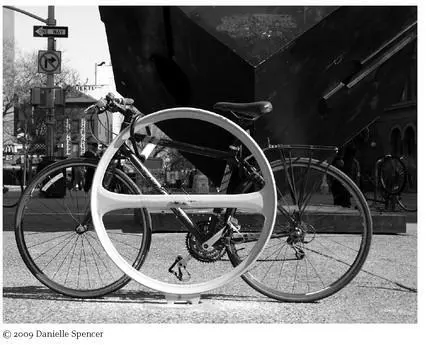
The system proved to be very successful and became a model for other cities around the world. Though not as clean and permanent as rail, it is cheaper and can be implemented quickly. (Rail has the added advantage of stations that are fixed, so shops and businesses spring up around them knowing that these station hubs will be around for a while). Unfortunately, Curitiba is still, to me, a pretty boring town, but these changes have made it much more livable for the residents.
Peñalosa implemented a similar plan in Bogotá, as well as creating the longest pedestrian (and bike) street in the world—twenty kilometers. He began by closing select streets on weekends, and then gradually, as businesses realized that this actually increased sales and improved the general mood, he added more days and closed more streets. It transformed the life of the city. Needless to say, it reduced the congestion as well. People came in contact with each other more often, went strolling, and enjoyed their city. Peñalosa had to fight an alternative plan that was already on the table—a $600 million highway project that would have both destroyed large parts of the city and not solved the problem, like what Robert Moses did to New York City.
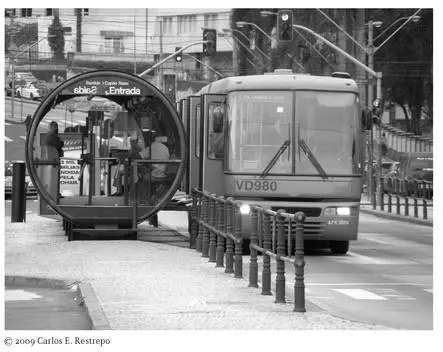
Here are more of Peñalosa’s thoughts, from a piece he wrote called “The Politics of Happiness”:One common measure of how clean a mountain stream is is to look for trout. If you find the trout, the habitat is healthy. It’s the same way with children in a city. Children are a kind of indicator species. If we can build a successful city for children, we will have a successful city for all people. . . .All this pedestrian infrastructure shows respect for human dignity. We’re telling people, “You are important—not because you’re rich or because you have a Ph.D., but because you are human.” If people are treated as special, as sacred even, they behave that way. This creates a different kind of society.
While at Columbia University I am introduced to some of the local New York political players: the head of the Taxi and Limousine Commission, someone from the Department of Transportation, a rep from the borough president’s office. It’s another world for me, not really one I feel that comfortable in. Peñalosa takes the stage and shows some slides of Bogotá and talks about what he did there. Among the things he says:• Traffic jams are not always bad. The priority should not always be to relieve them. They will force people to use public transportation.• Transportation is not an end—it is a means to having a better life, a more enjoyable life—the real goal is not [just] to improve transportation but to improve the quality of life.• A place without sidewalks privileges the automobile, and therefore the richer people in cars have more rights; this is undemocratic.
Peñalosa tends to link equality, in all its forms, with democracy—a connection that is anathema to many in the United States. In his words, “In developing-world cities, the majority of people don’t have cars, so I will say, when you construct a good sidewalk, you are constructing democracy. A sidewalk is a symbol of equality. . . . If democracy is to prevail, public good must prevail over private interests.”
Читать дальше





